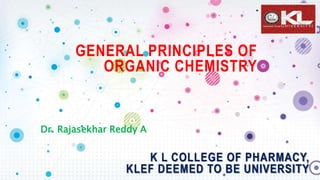
Organic Chemistry Principles Explained
- 1. GENERAL PRINCIPLES OF ORGANIC CHEMISTRY Dr. Rajasekhar Reddy A K L COLLEGE OF PHARMACY, KLEF DEEMED TO BE UNIVERSITY
- 2. ATOMIC STRUCTURE: All matter is composed of the same building blocks called atoms. There are two main components of an atom. The nucleus contains positively charged protons and uncharged neutrons. Most of the mass of the atom is contained in the nucleus. The electron cloud is composed of negatively charged electrons. The electron cloud comprises most of the volume of the atom.
- 3. ATOMIC STRUCTURE: The charge on a proton is equal in magnitude but opposite in sign to the charge on an electron. In a neutral atom, the number of protons in the nucleus equals the number of electrons. This quantity, called the atomic number, is unique to a particular element. For example, every neutral carbon atom has an atomic number of six, meaning it has six protons in its nucleus and six electrons surrounding the nucleus. A cation is positively charged and has fewer electrons than its neutral form. An anion is negatively charged and has more electrons than its neutral form. The mass number of an atom is the total number of protons and neutrons in the nucleus.
- 4. ATOMIC ORBITALS AND QUANTUM NUMBERS The relation of a particular electron to the nucleus can be described through a series of four numbers, called the Quantum Numbers. The first three of these numbers describe the energy (Principle quantum number, n), shape (Angular momentum quantum number, l), and orientation of the orbital (magnetic quantum number, m). The fourth number represents the "spin" of the electron (spin quantum number).
- 5. ATOMIC STRUCTURE: An orbital is a region of space that is high in electron density. There are four different kinds of orbitals, called s, p, d, and f. An s orbital has a sphere of electron density. It is lower in energy than other orbitals of the same shell, because electrons are kept close to the positively charged nucleus. An s orbital is filled with electrons before a p orbital in the same shell. A p orbital has a dumbbell shape. It contains a node of electron density at the nucleus. A node means there is no electron density in this region. A p orbital is higher in energy than an s orbital (in the same shell) because its electron density is farther away from the nucleus. A p orbital is filled with electrons only after an s orbital of the same shell is full.
- 6. The s orbital (l = 0) has one orbital, since m can only equal 0. That orbital is spherically The p orbital (l = 1) has three orbitals, since m = -1, 0, and 1. These three orbitals lie along the x-, y-, and z-axes. The d orbital (l = 2) has five orbitals, since m = -2, - 1, 0, 1, and 2. It is far more difficult to describe the
- 7. MULTI-ELECTRON ATOMS ELECTRON CONFIGURATION The electrons in an atom fill up its atomic orbitals according to the Aufbau Principle; Electrons always fill orbitals of lower energy first. 1s is filled before 2s, and 2s before 2p. The Pauli Exclusion Principle states no two electrons within a particular atom can have identical quantum numbers. In function, this principle means that if two electrons occupy the same orbital, they must have opposite spin. Hund's Rule states that when an electron joins an atom and has to choose between two or more orbitals of the same energy, the electron will prefer to enter an empty orbital rather than one already occupied. As more electrons are added to the atom, these electrons tend to half-fill orbitals of the same
- 8. THE OCTET RULE The octet rule states that atoms become especially stable when their valence shells gain a full complement of valence electrons. For example, in above, Helium (He) and Neon (Ne) have outer valence shells that are completely filled, so neither has a tendency to gain or lose electrons. Therefore, Helium and Neon, two of the so-called Noble gases, exist in free atomic form and do not usually form chemical bonds with other atoms. Most elements, however, do not have a full outer shell and are too unstable to exist as free atoms. Instead they seek to fill their outer electron shells by forming chemical bonds with other atoms and thereby attain Noble Gas configuration. An element will tend to take the shortest path to achieving Noble Gas configuration, whether that means gaining or losing one electron.
